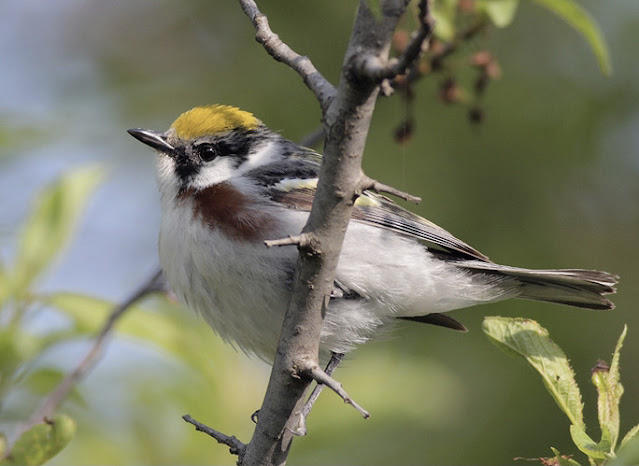with 13 of them being rare or very rare. We have so many warblers migrating into NB in the spring that they can be seen as a huge patch on radar screens as they wing their way here. New Brunswick (and eastern Canada) are unique in the world with the diversity and beauty of wood warblers present in spring, summer and fall. European birders, for example, envy us.
The Chestnut-sided Warbler (Setophaga pensylvanica) is a typically sized warbler; 13 cm long. They are common here and can be seen flitting around bushes and low shrubbery gleaning insects from under the leaves. They are fast-moving but so worth getting a good look at or a photo. They often droop their wings and cock their tail.
Chestnut-sided WarblerThe male and female adults look much alike, the female being duller with less black and chestnut markings. The adult male is beautiful with his bright yellow crown (deep gold or green gold (in artist speak)), black lores, eyeline and malar stripe. Note the big chestnut stripe on the sides of his breast and flanks, the white throat and breast and the white cheek. He has 2 pale yellow wing bars, some yellow in his wings and striping on the back.
The fall plumage is very different, as it often is in warblers. In the fall both male and female have bright lime green (green gold) upper parts including crown and a pale gray cheek, throat and upper breast. Of note is the white complete eyering. In my experience, when you see a fall-plumaged Chestnut-sided Warbler the greenish upper parts jump out at you. All you need to know is that this is a Chestnut-sided Warbler!
What similar species do you need to know? The breeding plumage is distinctive so no problems in identification there. In the fall, you need to distinguish them from fall-plumaged Bay-breasted Warblers and Blackpoll Warblers. But the green upper parts and eyering identify it as the Chestnut-sided Warbler.
The Chestnut-sided Warbler song is described as rich and musical and can be learned by interpreting it as 'please please pleased to meetcha'. This makes learning this song easy. There can be two different Chestnut-sided Warbler songs. The one described above is used by the male to attract a female. It decreases in frequency as the female sits on the eggs. This song is known as the 'accented song'. Males also sing an 'unaccented song'. That is a song with the 'meetcha' removed from the end. This song is used in territory defence and in warding off other males. Research has shown that some males sing only the 'unaccented song' and that those males are less successful in finding mates. The females must like the accent on the end of the song!
The range of the Chestnut-sided Warbler is most of eastern Canada from the central prairies to Nova Scotia, around the Great Lakes and down into the eastern US. They winter in southern Mexico and Central America. It is hard to believe this beautiful little bird can travel that far! The preferred habitat of this species is second growth forest and scrubland. Because so much of our forests were cut in the late 19th and 20th centuries, the second growth accelerated the population numbers of this species. Unfortunately they have been declining some in recent years.
Chestnut-sided Warblers feed mainly on insects but also on some fruits. They build their nests a few feet above the ground in a small tree or bush. The nest is made of grass and bark and lined with hair and rootlets. Three to five white to pale green eggs blotched with purple or brown are laid and incubated 11 to 13 days by the female.
Chestnut-sided Warblers are neat warblers to learn and appreciate. Ornithologists tell us that even though they have had a decline in numbers their population is still listed as 'least concern'. If you haven't seen this species, go outside into the bushes and low trees and listen for 'please please pleased to meetcha'. You will be happy to meet his beautiful warbler.



No comments:
Post a Comment